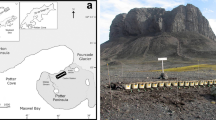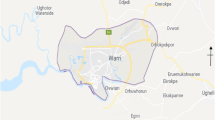Abstract
The chemical–biological stabilization technology has been employed in several successful studies using sugarcane cachasse as the organic amendment. However, in some petroleum-producing areas, there are no sugar mills nearby (which is the source of this material), and the cost of transport to the contaminated site is prohibitive. Therefore, water lily, which is considered a weedy plant in many tropical and subtropical areas, was evaluated as an alternative. In 3-month experiment, water lily was compared (with and without addition of molasses) with cachasse for the treatment of clayey sediment contaminated with > 6% extra-heavy crude oil. All treatments resulted in a reduction in the hydrocarbon concentration of 15–23%, without significant differences (P > 0.05). During this process, the pH was reduced to the 7–7.5 range and water repellency (molarity ethanol drop) to 3.5–3.6 M. Also, field capacity increased to 36.3–38.5% humidity, establishing adequate conditions for the development of vegetation at this site. Likewise, toxicity was reduced to practically null (Vibrio fischeri bioassay), and hydrocarbons in leachates were reduced to 3.4–4.3 mg/l, conditions adequate for the protection of groundwater and human health in rural areas. This study confirms that water lily is an adequate substitute for the application of this treatment method for hydrocarbon-contaminated sites that are far from sugar production areas.



Similar content being viewed by others
References
Adams RH (2004) Chemical–biological stabilization of hydrocarbon-contaminated soil and drilling cuttings in tropical México. Land Contam Reclam 12:349–361
Adams RH (2008) Chemical–biological stabilization process for repairing soils and cuttings contaminated with oils and petroleum derivatives. US patent application no. 7,413,383. US Patent and Trademark Office, Washington. 19 Aug 2008
Adams RH, Guzmán-Osorio FJ (2008) Evaluation of land farming and chemico-biological stabilization for treatment of heavily contaminated sediments in a tropical environment. Int J Environ Sci Technol 5:169–178
Adams RH, Díaz-Ramírez IJ, Guzmán-Osorio FJ, Gutiérrez-Rojas M (2006) Biodegradation and detoxification of soil contaminated with heavily weathered hydrocarbons. In: 13th international environmental petroleum conference, international environmental petroleum consortium. San Antonio, Texas, 16–20 Oct
Adams RH, Guzmán-Osorio FJ, Álvarez-Rivera JA, Domínguez-Rodríguez VI (2007) Long term fertility monitoring of soil treated by the chemical–biological stabilization method. In: 14th international environmental petroleum conference, international environmental petroleum consortium. Houston, Texas, 6–9 Nov
Adams RH, Guzmán-Osorio FJ, Zavala-Cruz J (2008a) Water repellency in oil contaminated sandy and clayey soils. Int J Environ Sci Technol 5:445–454
Adams RH, Zavala-Cruz J, Morales-García F (2008b) Concentración residual de hidrocarburos en suelo del trópico II: Afectación a la fertilidad y su recuperación. Interciencia 33:483–489
Adams RH, Olán-Castro D, Guzmán-Osorio FJ, Díaz-Ramírez IJ (2009) Relationship between geomorphology and contamination with weathered hydrocarbons in an old river levee/marsh association. Int J Environ Sci Technol 6:527–538
Adams RH, Guzmán-Osorio FJ, Domínguez-Rodríguez VI (2014) Field-scale evaluation of the chemical–biological stabilization process for the remediation of hydrocarbon-contaminated soil. Int J Environ Sci Technol 11:1343–1352
Adams RH, Álvarez-Ovando AL, Castañón N (2015a) Efecto de la concentración de hidrocarburos sobre la producción del pasto (Brachiariahumidicola) en Texistepec, Veracruz. Rev Int Bot Exp 84:222–232
Adams RH, Domínguez-Rodríguez VI, Zavala-Cruz J (2015b) Vibrio fischeri bioassay for determination of toxicity in petroleum contaminated soils from tropical Southeast Mexico. Sains Malays 44:337–346
Chakraborty S, Weindorf DC, Li B, Ali MN, Majumdar K, Ray DP (2014) Analysis of petroleum contaminated soils by spectral modeling and pure response profile recovery of n-hexane. Environ Pollut 190:10–18
EPA (1997) Test methods for evaluating solid waste: physical/chemical methods. Environmental Protection Agency, publication no. EPA 530/SW-846
Guzmán-Osorio FJ, Adams RH (2015) Mitigation of water repellency in the treatment of contaminated muds using the chemical–biological stabilization process. Int J Environ Sci Technol 12:2071–2078
Kirkham MB (2005) Principles of soil and plant water relations. Ann Bot-Lond 96:499–500
Kross BC, Cherryholmes K (1993) Toxicity screening of sanitary landfill leachates: a comparative evaluation with Microtox analyses, chemical, and other toxicity screening methods. In: Richardson ML (ed) Ecotoxicology monitoring. VCH Publishers, Weinheim, pp 225–249
Lal R, Shukla MK (2004) Principles of soil physics. Marcel Dekker, New York
Mayo-López TM, Adams RH, Domínguez-Rodríguez VI, Guzmán-Osorio FJ (2010) Organic amendment optimization for treatment of hydrocarbon contaminated soil using the chemical biological stabilization process. Afr J Biotechnol 9:7079–7085
Patel S (2012) Threats, management and envisaged utilizations of aquatic weed Eichhorniacrassipes: an overview. Rev Environ Sci Bio Technol 11:249–259
Qin H, Zhang Z, Liu M, Liu H, Wang Y, Wen X, Zhang Y, Yan S (2016) Site test of phytoremediation of an open pond contaminated with domestic sewage using water hyacinth and water lettuce. Ecol Eng 95:753–762
Rezania S, Ponraj M, Din MFM, Songip AR, Sairan FM, Chelliapan S (2015) The diverse applications of water hyacinth with main focus on sustainable energy and production for new era: an overview. Renew Sustain Energy 41:943–954
SECOFI (1996) Norma Mexicana NMX-AA-112-1995-SCFI, Análisis de agua y sedimento—evaluación de toxicidad aguda con Photobacterium phosphoreum—Método de prueba. Secretaría de Comercio y Fomento Industrial. Dirección General de Normas, 6 marzo. México DF
SEMARNAT (2002) Norma Oficial Mexicana NOM-021-SEMARNAT-2000, que establece las especificaciones de fertilidad, salinidad y clasificación de suelos, estudio, muestreo y análisis. Secretaría del Medio Ambiente y Recursos Naturales. Diario Oficial de la Federación, 31/12/2002. México DF
SEMARNAT (2003) Norma Oficial Mexicana NOM-053-SEMARNAT-1993, que establece el procedimiento para llevar a cabo la prueba de extracción para determinar los constituyentes que hacen a un residuo peligroso porsu toxicidad al ambiente. Secretaría del Medio Ambiente y Recursos Naturales. Diario Oficial de la Federación, 23/04/2003. México DF
WDEQ (2003) Appendix, cleanup levels for total petroleum hydrocarbons in soil and groundwater. In fact sheet no. 12, soil cleanup level look-up table under the voluntary remediation program. Wyoming Department of Environmental Quality, 05/09/03 v. 5
Zheng JC, Liu HQ, Feng HM, Li WW, Lam MHW, Lam PKS, Yu HQ (2016) Competitive sorption of heavy metals by water hyacinth roots. Environ Pollut 219:837–845
Acknowledgements
This study was financed by the Remediation Laboratory of the Academic Division of Biological Sciences (Universidad Juárez Autónoma de Tabasco) under internal Grant Number UJAT-LBR-2012-06. We are very grateful to Mr. Héctor López Guerrero and Mr. Juan Avila Gonzales (both previously from Pemex Gas y Petroquímica Básica) for their assistance with access to the Mining Unit to obtain material for treatment.
Author information
Authors and Affiliations
Corresponding author
Additional information
Editorial responsibility: M. Abbaspour.
Rights and permissions
About this article
Cite this article
Domínguez-Rodríguez, V.I., Adams-Schroeder, R.H., Goñi-Arévalo, J.A. et al. Water lily (Nymphaea sp.): an alternative organic amendment for treatment of hydrocarbon-contaminated soil by chemical–biological stabilization. Int. J. Environ. Sci. Technol. 15, 1851–1858 (2018). https://doi.org/10.1007/s13762-017-1560-3
Received:
Revised:
Accepted:
Published:
Issue Date:
DOI: https://doi.org/10.1007/s13762-017-1560-3




